 ,1, Uzma Sajjad, Muhammad SajidDepartment of Physics,
,1, Uzma Sajjad, Muhammad SajidDepartment of Physics, First author contact:
Received:2019-10-2Revised:2020-02-14Accepted:2020-02-26Online:2020-05-13

Abstract
Keywords:
PDF (763KB)MetadataMetricsRelated articlesExportEndNote|Ris|BibtexFavorite
Cite this article
Rashid Ahmad, Uzma Sajjad, Muhammad Sajid. One-dimensional quantum walks with a position-dependent coin. Communications in Theoretical Physics, 2020, 72(6): 065101- doi:10.1088/1572-9494/ab7ec5
1. Introduction
Classical random walks are widely used fundamental models of natural sciences in which the position of a classical particle is shifted depending upon the outcome of a classical coin. Such walks have found applications in different research areas including diffusion and mobility in materials [1], Brownian motion [2], polymer statistics [3], exchange rate forecast [4], solution of differential equations [5], quantum Monte Carlo techniques [6], and randomized algorithms [7]. Quantum random walks, motivated by classical random walks, were initiated by Aharonov et al in 1993 [8]. In quantum walks, a unitary process for a quantum particle (also known as a walker), i.e. electron, ion, atom, or photon, replaces the stochastic evolution of a classical particle. Thus quantum walks become fundamentally different from their classical counterpart due to quantum interference that arises when different trajectories of the walker intersect each other, hence leading to a very different probability distribution [9, 10].There are basically two kinds of quantum walk which have already received a good deal of attention: continuous quantum walks [11–13] and discrete-time quantum walks (DTQWs) [14–16]. DTQWs have received much attention because of their applications in various disciplines. In physics, DTQWs are employed for the simulation of different physical phenomena, e.g. topological phenomena in condensed matter systems [17–20], quantum percolation [21], and the effect of disorder on quantum transport [22–24]. In quantum information sciences, due to the faster expansion of quantum walks compared to classical ones, DTQWs are used to develop fast algorithms for computations on a quantum computer [14, 25–33].
These applications have motivated the study of various properties of DTQWs [34–42] and have been realized in numerous experiments using different physical settings including neutral atoms [43–45], photons [46–50], trapped ions [51, 52], and superconducting qubits [53]. To control their behavior, different types of walks have been studied, e.g. DTQWs with decoherence [54, 55]. In a similar vein, recently coherent quantum walks with a step-dependent coin (SDC) operator have been studied [56]. Such a coin operator can be used to obtain the desired probability distribution by controlling the rotation angle. The authors considered different rotation angles and observed diverse probability distributions which are classified into different classes. This motivates us to consider whether quantum walks can also be controlled using a position-dependent coin (PDC) operator.
Moreover, quantum walks of a group of interacting particles in the realm of quantum computing [57] made it possible to link the phenomenon of quantum entanglement [58] with it. The entanglement of quantum bits will allow quantum computers to perform certain calculations much faster than common classical computers. In this context progress has been made, e.g. quantum walks on a line with two entangled particles [59], entanglement and interaction in a topological quantum walk [60], entanglement in quantum walks on a regular graph [61]. In addition, a mathematical model was formulated to understand unrestricted quantum walks using two entangled coins [62]. They demonstrated that the behavior of a walk with entangled coins is different as compared to the usual quantum walks using a single coin. Moreover, one-dimensional quantum walks with four internal degrees of freedom, i.e. two entangled coins, have been recently reported [63]. They have shown that entanglement between two coins could be used as a resource for obtaining different probability distributions in position space. We extend this study to one-dimensional quantum walks with two position-dependent entangled coins (PDEC).
This article is organized in the following way: in section
2. Quantum walk with PDC
In DTQWs the evolution of a walker is controlled by a couple of unitary operators including a ‘coin operator’ and a ‘conditional shift operator’, applied repeatedly. A coin operator acts on the internal states of a walker, which for a walker with two internal degrees of freedom (similar to a spin-1/2 particle) are generally known as the spin-up state and the spin-down state. The conditional shift operator acts on the external degrees of freedom and moves a walker either to the left or right depending on its internal state. Here, we consider a single-qubit walker, i.e. a walker with two internal degrees of freedom, on a one-dimensional lattice. For a single-qubit walker, the Hilbert space ${{ \mathcal H }}_{c}$ associated with the internal states is spanned by state vectors $| 0\rangle ,| 1\rangle $. The Hilbert space ${{ \mathcal H }}_{p}$ associated with the position space is spanned by state vectors $| x\rangle :x$ $\epsilon \ {\mathbb{Z}}$. Thus the Hilbert space of the system is the tensor product of the two Hilbert spaces, i.e. ${{ \mathcal H }}_{c}\otimes {{ \mathcal H }}_{p}$. The PDC operator is defined asWe consider the following initial states to study the evolution of the quantum walk with PDC operator
2.1. Classification of probability distributions
From equations (2.1.1. Free localized walk
For rotation angle θ=0, the evolution of the walk shows that the walker is at position x=T with probability 1 after T steps as shown in figure 1(a). For this rotation angle the coin operator is an identity operator, and hence does not change the internal state of the walker. As a result the walker initially prepared in the spin-up state remains in the same internal state during the evolution of the walk and shifts to the right by a unit distance at each step of the walk.Figure 1.
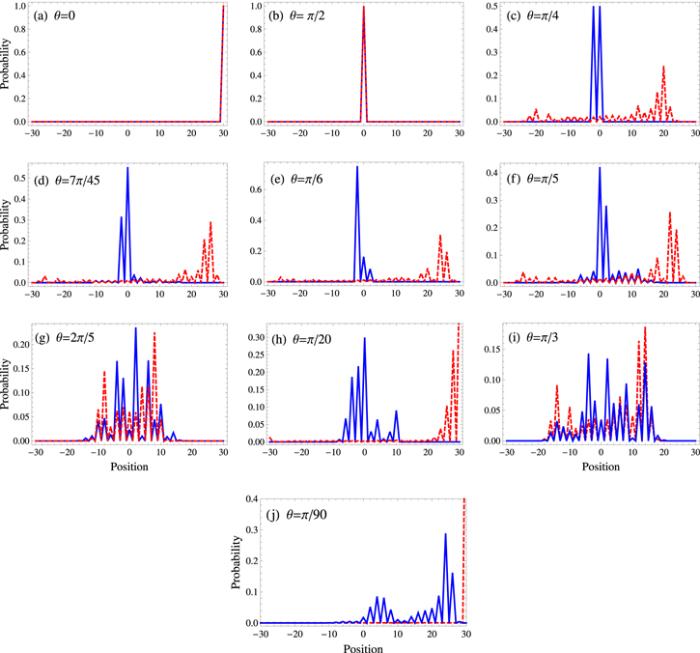 New window|Download| PPT slide
New window|Download| PPT slideFigure 1.Probability distribution of the walk after T=30 for different rotation angles θ (indicated in the inset). The solid blue line represents the quantum walk with a position-dependent coin, and the dashed red line represents the quantum walk with a position-independent coin.
2.1.2. Bounded localized walk
For a rotation angle π/2, the walker is bounded to three positions ($x=0,\pm 1$) irrespective of the number of steps. The walker is localized because the probability is 1 at any of the three possible positions. The probability distribution of the walker after T=30 is shown in figure 1(b). This localization can be explained as follows. The coin operator is the identity operator at the initial position x=0, and acts as a spin-flip operator (changing spin-up to spin-down and vice versa) at x=±1. Hence, a walker initially prepared in the spin-up state will shift to the right during its evolution and will be reflected back from x=1. It will start moving to the left but will be reflected back again from the x=−1 position. This way the walker will oscillate between x=+1 and x=−1. For this rotation angle, the walk with PIC shows that the walker is localized and bounded to two positions (x=−1,0).2.1.3. Bounded periodic walk
For a rotation angle π/4, the probability distribution shows the periodic behavior of a localized two-peak-zone and three-peak-zone for different numbers of steps. The probability is 1 at x=0 position (localized) for a certain number of steps, or equally distributed between positions x=±1 (two-peaks-zone), or distributed among positions 0,±2 with probabilities 0.5, 0.25 and 0.25, respectively (three-peak-zone). The probability distribution is shown in figure 1(c) for T=30, which shows the two-peak-zone. Moreover for this rotation angle, the coin operator becomes a spin-flip operator at x=±2, and hence the walker remains trapped between these positions. For this rotation angle, PIC is a simple Hadamard coin which shows an asymmetric probability distribution.2.1.4. Classical-like walk
For a rotation angle 7π/45, the probability distribution shows Gaussian-like behavior, i.e. the maximum probability of finding the walker is at (or near) the x=0 position, and there is a comparatively smaller but non zero probability of finding the walker around the most probable position. For this rotation angle, a walk with PIC shows the maximum probability of finding the walker away from the initial position (figure 1(d)).2.1.5. Bounded classical-like walk
For a rotation angle π/6, the probability distribution shows classical-like behavior but is bounded (see figure 1(e)). Here, the coin operator becomes a spin-flip operator at x=±3 and hence the walker gets reflected from these positions and becomes bounded to seven lattice sites. For this rotation angle, a walk with PIC is not bounded and the walker spreads away from its initial position.2.1.6. Fast classical-like walk
For a rotation angle π/5, the probability distribution of the walk is Gaussian-like but for a given value of T the number of positions occupied by the walker is greater compared to the classical-like walk. Moreover, in the case of a fast classical-like walk the number of occupied positions increases more rapidly than the case of a classical-like walk. For this rotation angle, PIC shows the maximum probability away from the initial position (figure 1(f)).2.1.7. Semi-classical-like walk
For a rotation angle 2π/5, the probability of finding the walker is maximum near the center of the occupied positions. There are other significant peaks towards the sides of the highest peak. We call this walk a semi-classical-like walk. For this rotation angle a walk with PIC shows the maximum probability towards the right (figure 1(g)).2.1.8. Bounded semi-classical-like walk
For a rotation angle π/20, the probability distribution is semi-classical-like but is bounded to 31 lattice sites. The coin operator becomes a spin-flip operator at x=±15 and thus the walker cannot surpass these positions. We call the walk with this type of probability distribution a bounded semi-classical-like walk. The PIC for this rotation angle shows the maximum probability towards the right (figure 1(h)).2.1.9. Fast semi-classical-like walk
For a rotation angle π/3, the probability distribution is semi-classical-like but the number of occupied positions is greater compared to the semi-classical-like walk. The PIC for this angle is semi-classical-like but not fast (figure 1(i)).2.1.10. Bounded quantum-like walk
For a rotation angle π/90, the walk shows ballistic, asymmetric expansion. The walk is quantum-like but is bounded to finite positions. For this rotation angle the coin operator becomes a spin-flip operator at x=±45. We call this a bounded quantum-like walk. For this rotation angle, PIC shows the maximum probability at position x=T (figure 1(j)).2.2. Shannon entropy
The idea of Shannon entropy was presented by Claude Shannon in 1948 [66]. In quantum walks, the Shannon entropy was introduced and numerically studied for a Hadamard coin [67, 68]. The Shannon entropy for each step of a walk is determined from the probabilities of positions and internal degrees of freedom occupied by a wave function. In quantum walks with PDC the Shannon entropy depends on the choice of rotation angle. We compute the Shannon entropy associated with position space (SP) and coin space (SC) for the PDC, and compare it with the case of PIC. The Shannon entropy is defined asFor other rotation angles, the evolution of entropy shows three types of behavior, i.e. bounded periodic, bounded, and unbounded.
For a bounded periodic walk (θ=π/4) the entropy is bounded periodic as the uncertainty in the position state of the system periodically changes. Whenever the walker is localized the entropy of the state is 0, for the two-peak-zone entropy is 0.7, and for the three-peak-zone the entropy is 1, as shown in figure 2(a).
Entropies of the bounded walks are bounded but non-periodic. In this case the entropies of the walk do not increase after reaching their corresponding maximum limit, as shown in figures 2(b), (e), (h).
For other classes of walk the behavior of the Shannon entropy is unbounded, i.e. it increases with the number of steps, as shown in figures 2(c), (d), (f), (g).
The entropy for a quantum walk with PDC is lower as compared to PIC except for the bounded quantum-like walk. The exception is because this class of walk is observed for a small rotation angle (closer to 0). In this case, a quantum walk with PIC shows localized-like behavior and hence the corresponding entropy of the walk becomes lower. The same trend in the entropy is seen in the case of a bounded semi-classical-like walk. However, here this holds only for a smaller number of steps. For semi-classical-like and fast semi-classical-like walks the entropy has the same behavior for PDC and PIC. In both types of walk, the entropy increases with the number of steps.
The Shannon entropy (SC) associated with the coin space of the walker in the case of PIC shows periodic behavior irrespective of the value of the rotation angle. For the walk with PDC, we observe the following: For a periodic walk SC shows periodic behavior. When the walk is localized then SC is zero, similar to SP. This takes place for specific values of T in a periodic walk.
For all subclasses of the classical-like walks SC is lower compared to their PIC counterparts. Generally, our results show that SC of a walk with PDC is lower compared to PIC except for the bounded semi-classical-like and bounded quantum-like walks. For semi-classical-like and fast semi-classical-like walks, SC is almost same and increases with the number of steps in both PDC and PIC cases.
Figure 2.
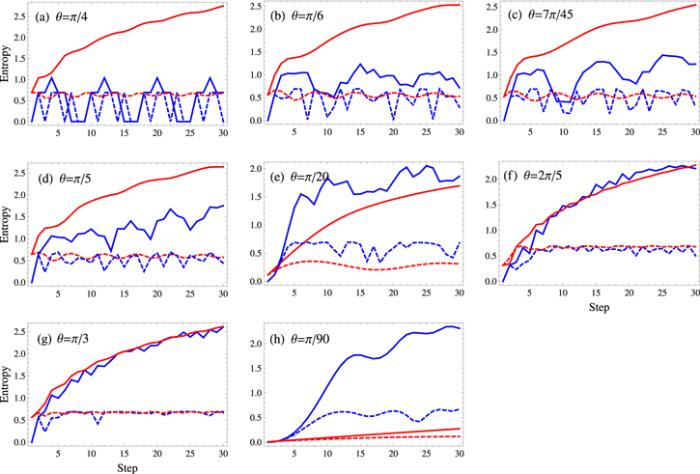 New window|Download| PPT slide
New window|Download| PPT slideFigure 2.Shannon entropy versus the number of steps T. The blue line represents the quantum walk with PDC and the red line represents the quantum walk with PIC. The solid (dashed) line indicates the Shannon entropy associated with the position (coin) space.
Table 1.
Table 1.Classification of the probability distribution for quantum walks with a position-dependent coin.
| Classes of walk | Rotation angle (θ) |
|---|---|
| Free localized walk | 0 |
| Bounded localized walk | π/2 |
| Bounded periodic walk | π/4 |
| Classical-like walk | 7π/45 |
| Bounded classical-like walk | π/6 |
| Fast classical-like walk | π/5 |
| Semi-classical-like walk | 2π/5 |
| Bounded semi-classical-like walk | π/20 |
| Fast semi-classical-like walk | π/3 |
| Bounded quantum-like walk | π/90 |
New window|CSV
2.3. Standard deviation
We compute the standard deviation (σ) for all classes of quantum walk with PDC. The results are shown in figure 3. For localized walks (both free and bounded) the standard deviation is 0, and for periodic walks it changes periodically. For other classes of walk we observe the following.Figure 3.
 New window|Download| PPT slide
New window|Download| PPT slideFigure 3.Standard deviation (σ) versus the number of steps of the walk for T=30. (a) The dashed red line shows the standard deviation of a simple classical random walk ($\sigma =\sqrt{T}$). The dotted blue line represents a bounded classical-like walk, the solid blue line represents a normal classical-like walk, and the dashed blue line represents a fast classical-like walk. (b) The dotted red line shows the standard deviation of a simple Hadamard walk with position-independent coin ($\sigma \approx T$). The dotted blue line represents a bounded semi-classical-like walk, the solid blue line represents a normal semi-classical-like walk, and the dashed blue line represents a fast semi-classical-like walk. (c) The dotted red line shows the standard deviation of a simple Hadamard walk with a position-independent coin ($\sigma \approx T$). The dotted blue line represents a bounded quantum-like walk.
2.3.1. Classical-like walk
We compute the standard deviation of all three subclasses of the classical-like walk and compare it with the σ of the standard classical random walk (see figure 3(a)). The square root dependence of the σ on the number of steps (T) of the walk justifies their classification as a classical-like walk. Moreover, for a rotation angle π/5 the σ is greater than the other subclasses, which shows that for this rotation angle the classical-like walk spreads faster. In case of a bounded classical-like walk, σ does not increase from a certain maximum limit.2.3.2. Semi-classical-like walk
For all the subclasses of semi-classical-like walk we compare the standard deviations of a quantum walk with a position-independent Hadamard coin. The walker’s initial state is chosen as in equation (2.3.3. Quantum-like walk
For the quantum-like walk we have only one subclass, i.e. a bounded quantum-like walk. We compare the standard deviation of this walk to the standard deviation of a Hadamard walk. Our results show that the standard deviation of this walk increases linearly for initial steps; however, because of the fact that the walker is bounded, the standard deviation does not increase further as shown in figure 3(c).3. Quantum walk with PDEC
We consider a walker with four internal degrees freedom to study a quantum walk with PDEC. The Hilbert space ${{ \mathcal H }}_{{EC}}$ associated with the internal states of the entangled two-qubit walker is spanned by the state vectors $| 00\rangle ,| 01\rangle ,| 10\rangle ,\mathrm{and}\,| 11\rangle $. The entangled coin operator is given by the tensor product of the two identical PDCs given in equation (3.1. Probability distribution
We study the evolution of the walk driven by PDEC, and compare it with the case of PIEC in order to demonstrate the effect of position dependence. We carry out numerical simulations for the two initial states given in equations (2. For θ=π/2, in figure 4(b) the probability distribution of the quantum walk with PDEC shows similar behavior to the one with PIEC. The walker is localized at position x=0 for an even number of steps. For odd values of T the probability of the walker splits equally on two lattice sites x=±1.
3. For θ=π/4, in figure 4(c) the probability distribution of the quantum walk with PDEC is periodic and bounded to the range of lattice sites x=±2. For any value of T there are three possible configurations of the probability distribution: (a) the walker has probability 1 at position x=0 (localized), (b) the walker occupies positions x=±1 each with probability 1/2, (c) the walker occupies positions x=0,±1 each with 1/4 probability, and x=±2 both with 1/8 probability. For this rotation angle, the probability distribution of the walk with PIEC shows a three-peak-zone. By increasing the number of steps the probability increases at the initial position. The behavior of the probability distribution does not depend on the choice of the initial state in contrast to the case of PDEC.
4. For θ=7π/45, in figure 4(d) the probability distribution of the walk with PDEC shows bounded behavior. Moreover, the walker has a higher probability at the initial position as compared to the other accessible lattice sites. In the case of PIEC, the number of occupied positions increases with the number of steps and the maximum probability is at positions x=±T.
5. For θ=π/5, in figure 4(e) the probability distribution of the walk with PDEC increases with T at the initial position, i.e. the walker becomes more localized as compared to the walk with PIEC.
6. For θ=π/90, in figure 4(f) the quantum walk with PDEC shows maximum probability towards the sides. Although there is a small probability near the initial position of the walker, it increases with the number of steps of the walk. For a quantum walk with PIEC the probability is maximum at positions x=±T, which resembles the case of θ=0.
Figure 4.
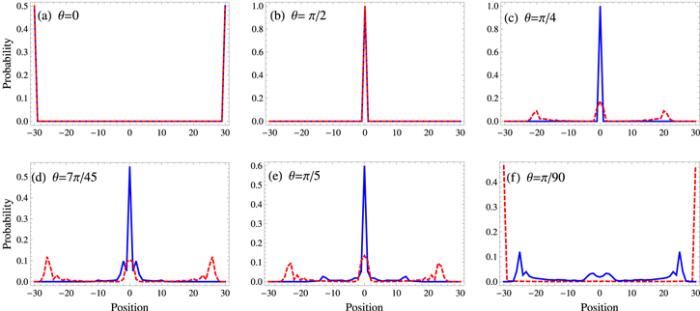 New window|Download| PPT slide
New window|Download| PPT slideFigure 4.Probability versus position for T=30 and initial state Φint1. The solid blue line represents position-dependent entangled coins (PDEC), and the dashed red line represents position-independent entangled coins (PIEC).
Generally, for the quantum walk with PDEC we observe that the walker is more localized at the initial position as compared to the quantum walk with PIEC (except for rotation angles closer to 0).
For the second choice of the initial state (Φint2) the probability distribution is plotted in figure 5 where our observations are as follows.
Figure 5.
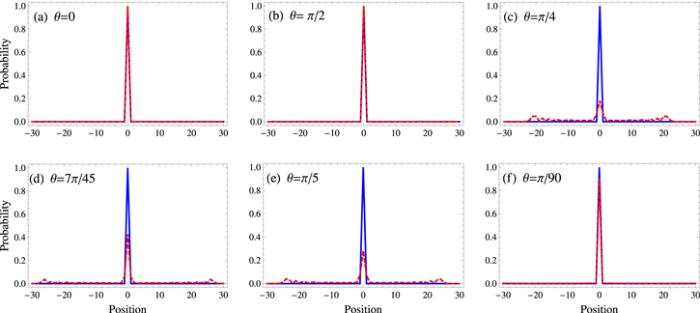 New window|Download| PPT slide
New window|Download| PPT slideFigure 5.Probability versus position for T=30 and initial state Φint2. The solid blue line represents position-dependent entangled coins, and the dashed red line represents position-independent entangled coins.
The stepwise evolution of the quantum walk with PDEC shows that the probability distribution does not depend on the choice of rotation angle. The walker is completely localized at the initial position for any choice of rotation angle and for any number of steps of the walk. This is because the shift operator ${\hat{S}}_{{EC}}$ does not change the position of a walker prepared in this particular internal state. The localization here is different from the well known Anderson localization [69] which arises due to spatial disorder in a system. In our case the localization is due to the shift operator ${\hat{S}}_{{EC}}$ which does not shift the walker in a particular internal state and thus remains trapped at the initial position.
The probability distribution in the case of PIEC changes with rotation angle. Although the most probable position is x=0 for different rotation angles, still the probability distribution does not show complete localization as in the case of PDEC (for example, see figures 4(c), (d), and (e)).
3.2. Shannon entropy
The Shannon entropy associated to the position space of the quantum walk with PDEC is plotted as a function of T for the initial state Φint1 (figure 6). For a pure maximally entangled state the entropy associated to coin space is zero. For position space we observe that the entropy is generally smaller for a walk with PDEC as compared to the walk with PIEC (except θ=π/90). This confirms the fact that PDEC localizes a walker as we have demonstrated on the basis of probability distribution (see figure 4). Additionally, for the initial state Φint2 the Shannon entropy is zero for any choice of rotation angle because of the localization of the walker.Figure 6.
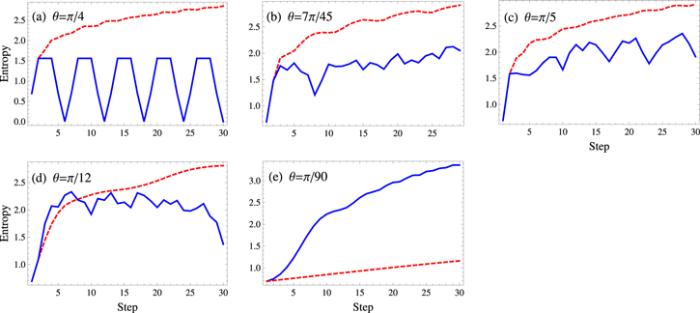 New window|Download| PPT slide
New window|Download| PPT slideFigure 6.Entropy versus the number of steps of the walk up to T=30 and initial state Φint1. The solid blue line represents the Shannon entropy of the quantum walk with position-dependent entangled coins (PDEC) and the dashed red line represents the case of position-independent entangled coins (PIEC). Entropy is lower for PDEC as compared to PIEC for different rotation angles except for θ=π/90.
4. Conclusion
We studied quantum walks in one dimension where the coin operator is characterized by a position-dependent rotation angle. We demonstrated that the probability distribution shows diverse behavior for different rotation angles. Based on the probability distribution we classified the walk in different classes. This classification shows that PDC serves as a controlling tool to obtain different probability distributions where the controlling parameter is the rotation angle.Moreover, we studied the effect of position dependence of the rotation angle on the Shannon entropy of the quantum walk by comparing with the position-independent case. We observed that the entropy in the case of PDC is smaller compared to the walk with PIC, except for the bounded semi-classical-like and bounded quantum-like walk. This exception occurs because of the relatively more localized behavior of the probability distribution in the case of PIC. Generally, the entropy of the quantum walk with PIC increases with the number of steps irrespective of the rotation angle. In the case of PDC the behavior of entropy depends on the rotation angle.
We further investigated 1D quantum walks with two identical PDEC. We considered two pure maximally entangled Bell states as the initial states of the quantum walks. We compared the probability distribution for the walk with PDEC to the case of PIEC. For the case of PDEC we observed that the probability distribution of the walker becomes bounded to limited positions. The walker becomes more localized as compared to PIEC, except for the rotation angles 0 and π/90. In the case of a specific initial state, the probability distribution showed that the walker becomes completely localized irrespective of the considered rotation angle. We also found that the Shannon entropy in the case of PDEC is smaller as compared to PIEC.
This study of PDC in 1D quantum walks can be generalized to study quantum walks with PDC in higher dimensions and with multi-particles. Moreover, the study of quantum walks with two PDEC can be generalized to more than two entangled qubits. The case of non-identical sub coins will be interesting to study, as will quantum walks using coins with different values of entanglement. We will leave these matters for future works.
Acknowledgments
US acknowledges S Panahiyan for his valuable suggestions.Reference By original order
By published year
By cited within times
By Impact factor
DOI:10.1016/S0370-1573(00)00070-3 [Cited within: 1]
DOI:10.1090/S0002-9947-1962-0139211-2 [Cited within: 1]
[Cited within: 1]
DOI:10.3386/w4119 [Cited within: 1]
DOI:10.1007/BF01398459 [Cited within: 1]
DOI:10.1126/science.231.4738.555 [Cited within: 1]
[Cited within: 1]
DOI:10.1103/PhysRevA.48.1687 [Cited within: 1]
DOI:10.1080/00107151031000110776 [Cited within: 1]
DOI:10.1007/s11128-012-0432-5 [Cited within: 1]
DOI:10.1103/PhysRevA.58.915 [Cited within: 1]
DOI:10.1103/PhysRevA.96.040301
DOI:10.1016/j.physrep.2011.01.002 [Cited within: 1]
DOI:10.1103/PhysRevA.81.042330 [Cited within: 2]
DOI:10.1088/1367-2630/18/7/073008
DOI:10.1103/PhysRevA.83.062315 [Cited within: 1]
DOI:10.1103/PhysRevA.82.033429 [Cited within: 1]
DOI:10.1103/PhysRevB.92.045424
DOI:10.1103/PhysRevB.84.195139
DOI:10.1103/PhysRevB.88.121406 [Cited within: 1]
DOI:10.1038/srep06583 [Cited within: 1]
DOI:10.1103/PhysRevE.82.031122 [Cited within: 2]
DOI:10.1103/PhysRevA.92.052311
DOI:10.1103/PhysRevA.94.023601 [Cited within: 1]
DOI:10.1145/780542.780552 [Cited within: 1]
DOI:10.1103/PhysRevA.70.022314
DOI:10.1103/PhysRevLett.92.177906
DOI:10.1137/S0097539705447311
DOI:10.1137/050643684
DOI:10.1142/S0219749903000383 [Cited within: 1]
DOI:10.1103/PhysRevA.67.052307
DOI:10.1103/PhysRevLett.102.180501
DOI:10.1126/science.1229957 [Cited within: 1]
DOI:10.1088/0305-4470/35/12/304 [Cited within: 1]
DOI:10.1142/S0219749906002195
DOI:10.1103/PhysRevA.67.052317
DOI:10.1103/PhysRevA.75.032351
DOI:10.1103/PhysRevLett.93.190503
DOI:10.1103/PhysRevA.67.032304
DOI:10.1088/0305-4470/37/30/013
DOI:10.1103/PhysRevA.67.042316
DOI:10.1103/PhysRevA.72.062317 [Cited within: 1]
DOI:10.1126/science.1174436 [Cited within: 1]
DOI:10.1103/PhysRevLett.110.190601
DOI:10.1103/PhysRevX.5.011003 [Cited within: 1]
DOI:10.1103/PhysRevLett.104.153602 [Cited within: 1]
DOI:10.1103/PhysRevLett.104.050502
DOI:10.1103/PhysRevLett.108.010502
DOI:10.1038/ncomms1872
DOI:10.1126/science.1193515 [Cited within: 1]
DOI:10.1103/PhysRevLett.104.100503 [Cited within: 1]
DOI:10.1103/PhysRevLett.103.090504 [Cited within: 1]
DOI:10.1103/PhysRevX.7.031023 [Cited within: 1]
DOI:10.1017/S0960129507006354 [Cited within: 1]
DOI:10.1088/1367-2630/16/12/123052 [Cited within: 1]
DOI:10.1088/1367-2630/aad899 [Cited within: 1]
DOI:10.1126/science.270.5234.255 [Cited within: 1]
DOI:10.1103/RevModPhys.81.865 [Cited within: 1]
DOI:10.1103/PhysRevA.74.042304 [Cited within: 1]
DOI:10.21468/SciPostPhys.5.2.019 [Cited within: 1]
DOI:10.1088/1367-2630/7/1/156 [Cited within: 1]
DOI:10.1088/1367-2630/7/1/221 [Cited within: 1]
[Cited within: 1]
[Cited within: 1]
DOI:10.1103/PhysRevA.80.052327 [Cited within: 1]
DOI:10.1002/j.1538-7305.1948.tb01338.x [Cited within: 1]
DOI:10.1088/0305-4470/37/8/L02 [Cited within: 1]
DOI:10.1103/PhysRevA.77.032326 [Cited within: 1]
DOI:10.1103/PhysRev.109.1492 [Cited within: 1]
